 |
| Ġgantija megalithic temple complex |
It is my opinion that the very ancient culture of Malta was of the proto-European root-stock going back to the last glacial movement. In other words, at least initially, even prior to the westward migration of the Mediterranean peoples. From an objective pre-Christian Western perspective, there was ancient Greece and Rome, but the ancient Maltese culture appears to have been more deeply spiritual. Also more ancient, dating back to about 4,000 BC. To me somehow, spiritual Malta represents the southern spiritual pillar of the West.
In the above link, under the sections History and Prehistory, you may find a slew of links regarding the megalithic temples and culture of ancient Malta. The Goddess of Fertility of the ancient Maltese is, I believe, the same goddess as in many other regions of Europe; such as Hecate and Diana. The Ggantija Prehistoric Temple in Gozo is the oldest free-standing building in the world (Wikipedia). These temples were probably linked to this ancient fertility cult; and within a much greater context, this is ultimately all linked to Margaret Mead's "Witch Cult," which existed in Europe-at-large up to about six thousand years ago.
According to local folklore, a giantess built these temples and used them as places of worship. One statue of the ancient Maltese fertility goddess is very similar to the famous fertility goddess statue found in Austria called the Venus of Willendorf, which has been dated to about 22,000 to 24,000 years ago. Malta was first populated about 7,200 years ago. This was all from one proto-European/"Alpine" culture initially; before the Germanic peoples, before the Mediterranean peoples.
 | |||||||
| Ósvör, a replica of an old fishing outpost outside Bolungarvík |
According to sources, the settlement of Iceland began in 874 AD by Norsemen. Apparently there was no proto-European presence prior to that time. Germanic peoples had, by this time, long been settled in northern Europe. This was the time of the Vikings, and Viking expansion. Iceland in particular has long been the last stronghold of Odinic spirituality; or what the Icelanders call "Ásatrú." The "Áses" were the gods and goddesses, and I have heard that Ásatrú means something like "being true to the gods." Being so far north, and in relative isolation, the island is something of a world unto itself.
The beautiful green volcanic island is right along the Arctic Circle. From the images, it appears to be beautifully sunny in the Summer, and wonderfully gloomy during the Winter. Apparently, historically-speaking, there has been a cultural exchange between the Icelandic Norse and Gaelic peoples. Some Icelanders look a little like certain dark haired Gaelic people; while some people from Ireland and Scotland look Norse. I see Iceland as the northern spiritual pillar of the West.
Iceland's best-known classical works of literature are the Icelanders' sagas, prose epics set in Iceland's age of settlement (Wikipedia). Ásatrú (pronounced [auːsatruː] in Icelandic, [aːsatruː] in Old Norse) is a modern Icelandic compound derived from Áss, which refers to the Æsir, an Old Norse term for the Gods, and trú, literally "faith". Thus, Ásatrú is the "faith in the Æsir" (Wikipedia).
When I think of these two islands, or island groups--within this historical/spiritual context--I think of the sacred northern pillar as "the Pillar of Freya," and I imagine it a rich light blue coming out of the cold Norwegian Sea on a dark cloudy Winter twilight. I think of the sacred southern pillar as "the Pillar of Hecate," and I imagine it to be a rich light copper color coming out of the warm blue Mediterranean Sea on a sunny Summer afternoon.
.

hello
ReplyDelete~Greeting~
ReplyDelete